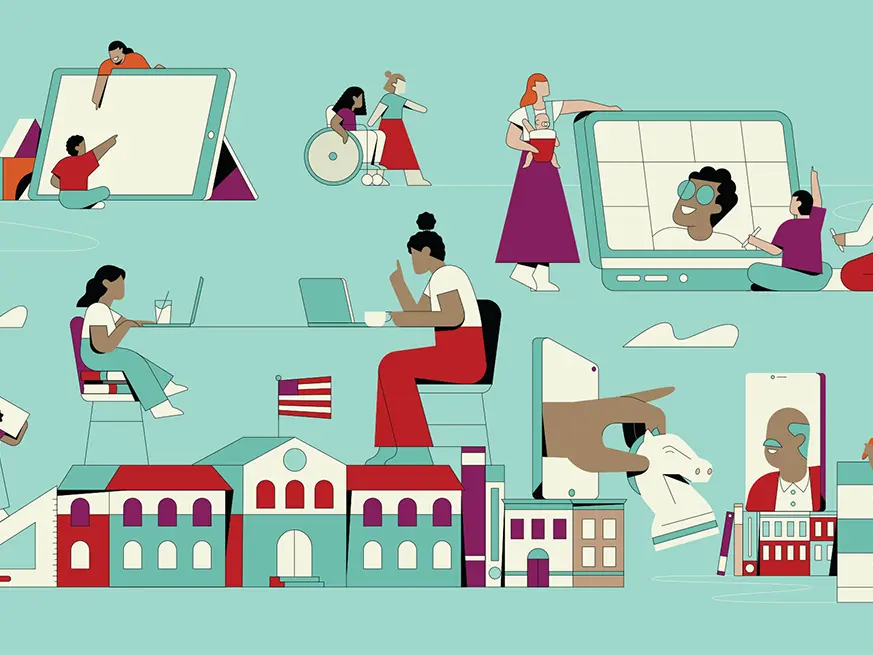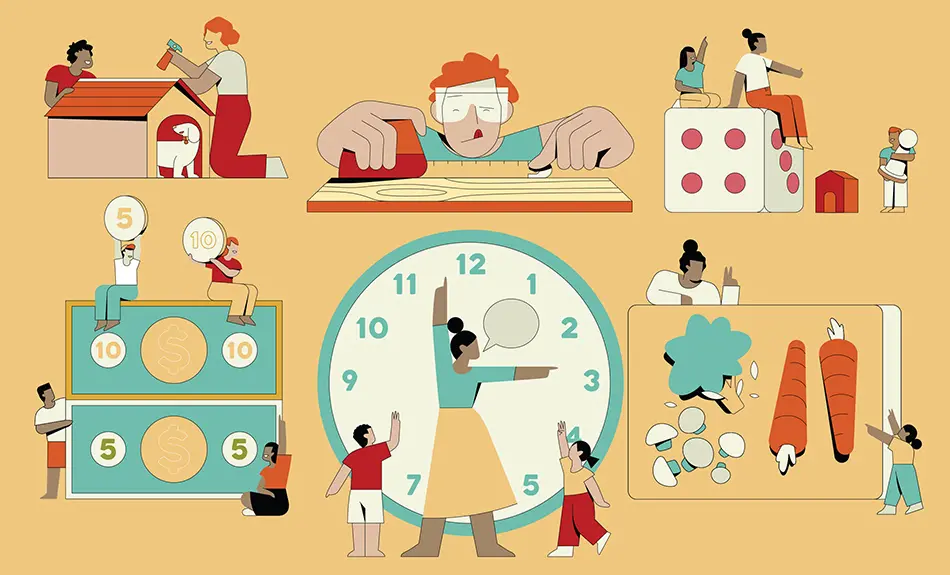

Life schools us: Education lessons from the pandemic
While serious challenges accompanied schooling during COVID-19, some practices actually offered improvements, experts say.
Seven-year-old Renee is all too aware of the challenges of learning during a pandemic. In October, with hybrid education in full swing because of COVID-19, the first-grader became so vexed with an uncooperative learning module that she chucked the family iPad across the room.
Her mother, doing her best to work full time in an adjoining room, heard the clunk. “We no longer have a number 2 on the keyboard,” she tells colleagues.
One year ago, K–12 students became en masse participants in an unintended educational experiment. The test: Can children — no matter their age or family circumstances — learn remotely? And, given the economic pressures and health concerns their families face, how can we help kids navigate the year’s seismic shift in education?
We now know the answer to both questions is, “Yes, but ….” Most children can learn away from their classrooms, but they need the tools and, importantly, the motivation to do it. Parents can help but sometimes are unable to because they are working, caring for others or don’t speak English or physics. The list of challenges goes on.
In a year consumed with concern, families and caregivers have struggled alongside children to create enough bandwidth, launch intractable computer programs and understand the intricacies of trigonometric functions. Now they worry, will it all be enough? Are their kids where they would have been academically had there been no pandemic?
To those questions, a panel of Ohio State education faculty and alumni responds: Don’t underestimate the powerful learning that happens when families interact, live in love and explore the world together.
We posed parents’ education concerns to three College of Education and Human Ecology faculty members, one Ohio superintendent and three alumni who teach different age groups in urban, rural and suburban settings.
They agree: Not all the takeaways from this vast learning exercise have been negative. Going forward, they say, K–12 education is likely to look different. We will learn from our mistakes, discover more and better ways to use technology, and integrate the family into education in ways we never have before.
Our experts
Theodore Chao
Associate Professor of Mathematics Education, College of Education and Human Ecology (EHE)
Children: second-grader, fourth-grader and sixth-grader
John Marschhausen
Superintendent-in-Residence, EHE
Superintendent, Hilliard (Ohio) City Schools
Children: a third-year in nursing and a first-year in special education, both at Ohio State
Antoinette Miranda
William H. and Laceryjette V. Casto Professor of Interprofessional Education
Interim Chair, Department of Teaching and Learning, EHE
Member, Ohio Board of Education, District 6
Antonia Mulvihill ’04 MA
English teacher, Beechcroft High School, Columbus City Schools
Megan Norris ’14, EHE master’s student
First-grade teacher at Beacon Elementary School, Hilliard, Ohio
Children: age 2; another due in June
Chris Van Reeth ’11
Special education teacher, Marietta (Ohio) Middle School
Kui Xie
Ted and Lois Cyphert Distinguished Professor of Teacher Education
Director, Ohio State’s Research Laboratory for Digital Learning
Children: a preschooler, a kindergartner and a fourth-grader
- Moderator (M): This has been a tough year for children. As the school year wraps up, what advice can you offer parents who want to prepare them academically for what lies ahead?
-
Associate professor Theodore Chao: It’s easy to look at what our students are not learning, as opposed to what our students are learning, through this pandemic. As parents — I have three children — it’s important for us to think about how we’ve had this opportunity to come together with our families, to really explore relationships and understand the complexity of how our society and inequities operate. This is a chance to get children to think critically — less about doing well on a math test or reading a book and regurgitating a report. But to be able to think in a really different way about learning.
I get this question a lot from parents: “I feel my kid’s not doing well in math.” I say, “As opposed to focusing on whether your kid is learning math, why not have conversations about math? Why not ask, ‘You come up with a math problem for me, and then try to solve it.’ Or, ‘Let’s do the math together, and you tell me what you’re thinking.’” That’s difficult in a traditional classroom, but parents can do that pretty easily and have the affordances to do it now.
We live in this wonderful space in which any question a kid asks can be answered immediately on a phone. Exploring learning together is really important. “I have no idea how many light years away that planet is. Let’s look it up together, and then let’s find out what a light year really is.” Those are ways parents can really engage children in learning.
Special education teacher Chris Van Reeth ’11: Students with disabilities are hit especially hard by this pandemic. I tell parents, “I understand you’re not a math teacher. You’re not a language arts teacher. But you are an adult, and you have skills to impart.” Counting money, telling time, skip counting, basic math facts: Those are things that parents can work on with children and that have an enormous impact when they go into the middle grades and high school.
First-grade teacher Megan Norris ’14: I’m a big proponent of life skills. Let young children struggle learning them: helping measure when you bake, sorting laundry. We live in a society where parents do everything for their children because they don’t want them to fail. However, failing is the best way for the brain to grow and learn.
- M: Some kids have checked out of learning — especially middle and high school students who may not feel motivated or have trouble focusing. How do you suggest connecting with those kids?
-
High school teacher Antonia Mulvihill ’04 MA: It’s important to give them a different kind of grace. To say, we have expectations, and we want you to meet them, but giving them some distance, some privacy (away from the all-seeing Zoom camera). I’ve created my curriculum to be slightly more personal, with much greater room for differentiation, based on their circumstances. Are you holding your older sister’s baby while participating in a college-level class because she has to work and there is no day care? Are your siblings on Zoom in the same room? Does someone in your family have COVID?
What’s most important is making kids feel they’re still part of something and that they have a future. The whole world has had so many bumps. All of these histrionics about how they’re getting behind… It’s not like we have interplanetary competition and the Martians are ahead because they don’t have COVID. Kids are learning different things. If I talk to a parent, I tell them, “Don’t worry. We’re going to figure this out, and together we’re going to triangulate and get your child over this COVID hump. And then we’re going to get back to life.” Keep encouraging your child.
Professor Kui Xie: I partner with schools to develop assessment plans on social emotional aspects of learning: motivation, self-regulation, belongingness, engagement. We need to be more aware of students’ social emotional status by using data. Without it, we’re making decisions in the dark.
Building relationships is an important step, because in remote learning, kids are isolated. They don’t have those high-five moments in school or recess time to build friendships, which are an essential part of motivation. The ways kids relate through their relationships — the values they share, the teams they’re on, the instruments they play in band, these different activities — are now happening at several different locations. We need to make sure our kids build connections.
Also, it’s important to help kids establish a workable routine. If you don’t stop and analyze the daily routine with your kids, especially those without self-regulation skills, kids don’t know what to do. Build a routine that works for your specific family situation.
Van Reeth: We get this question from parents day in and day out. First, create a learning environment that’s suitable for kids: simply a folding table in a corner with their computer, paper and pencil, calculator. Having space designated for schooling is important. In a traditional school setting, kids thrive on structure. Coming up with a workable routine motivates kids throughout the day and builds in breaks to their schedules.
Norris: The word of the year is grace. You have to give yourself grace. Yes, your child is not motivated. Yes, your child is not focused. We’re in a pandemic. If you must, use the “first and then” approach with younger kids. “First, you listen to the story, then you get to play with your Legos.” For my parents who were concerned, this was helpful to increase focus. Yes, it takes longer to get through their academics; however, they are more successful.
“It’s not like we have interplanetary competition and the Martians are ahead because they don’t have COVID. Kids are learning different things.”

- M: I’m worried about how the pandemic will affect my child’s performance on state assessments. Are there going to be modifications? Does that matter?
-
Professor Antoinette Miranda, a member of the Ohio Board of Education: Academically, most middle-class students will be OK because they have access to resources such as broadband and computers; their parents are more likely to work from home and can provide supervision. Research shows low-income students will lose more. We have to figure out how we can help those students. The State Board of Education is discussing: Is the assessment important — not to put on the state report card but as a diagnostic tool to look at learning gaps and how we begin to close them? Parents wonder if their kids will be behind; we need some type of assessment to see.
Superintendent John Marschhausen: Community educators have to develop an academic recovery plan that shows parents there’s hope. We’re going to work with your kids. In Hilliard, Ohio, we’re looking at an 18-month timetable that will involve two summer schools for kids who need it. We’re looking at the parks and rec department being part of that extended summer school. It will be academics 8 to 11 a.m., and then we’re at the pool, creating other opportunities so that summer school doesn’t feel like, “Ugh, I’m in school for 240 straight days.”
- M: COVID-19 has taken a toll on students’ mental health. What should I look for, and what resources do parents have if they see kids struggling with isolation and changing expectations?
-
Miranda: Some things to look for are loss of interest in activities kids once enjoyed, reduced feelings of anticipation, changes in weight, shifts in sleeping patterns. Are they sluggish? Do they have harsh self-assessment, especially when they’re feeling like they should be able to “get it”? Feelings of worthlessness and hopelessness can lead to thoughts of suicide. If those issues are present for at least two weeks, it can suggest a suicide risk. Get help. Reach out to your child’s school counselor, school psychologist, pediatrician or family physician, or look for a therapist.
Van Reeth: I work with a high-poverty population and with students who have disabilities. It’s a double whammy. Our advice is to reach out to the school counselor, who has a plethora of resources in the school and the community. Also, know that your child is not alone. Thousands of people across the state are going through this, and it’s OK to reach out. We really try to reduce that stigma of seeking help because that is one of the biggest barriers to assisting students with anxiety or depression.
Marschhausen: In December, 14 times more students from Hilliard schools were hospitalized for mental health issues than for COVID. Something we’ve found helpful is empowering our kids to speak up for their friends. So many calls for help are on social media, on TikTok or Snapchat. The call to “see something, say something” has saved lives, without a doubt, because kids are speaking up when they see their friends hurting. Parents should encourage their children to do that.

- M: This situation has forced us to do things very differently. What innovations are going to stick?
-
Xie: Now we know learning is everywhere, at home and in a virtual space as well. It can be successful, too. Technology integration, online learning, flipped classrooms, hybrid learning; these have been going on for a long time. But now it has come to the forefront. I’m not saying the pandemic is good, but it has caused learning technology to develop significantly. Not only have schools and teachers become more aware of its importance, but learning tech itself has evolved. Think of how many versions Zoom has gone through during the pandemic. I think many of these learning modes will stay because they have unique benefits to the education system. There are disadvantages, but we can take the benefits of remote learning, and many technologies will stay.
Chao: It takes so much time and money to build educational tech prototypes and test them in the classroom. Flipgrid, Nearpod, Google Classroom require so much bandwidth to build. Very rarely is a veteran educator at the heart of developing them from start to finish. But now educators have been thinking very thoughtfully about how to engage children. I’m hopeful that we will see a new generation of technology grounded in philosophies of teachers’ practice, written by and thought through by teachers themselves.
As a parent, I’ve never had such a deep relationship with my kids’ teachers as I do now. Being able to jump online with them, popping into my kids’ classroom just by walking into the room — it has been really nice. I think the teachers also feel that way. Community is different now. I’ve never felt more connected with the school community than I do now, in a completely virtual world. And it’s because it doesn’t require me to drive 20 minutes to their school.
Mulvihill: Twice I’ve had grandparents pipe up at the end of a class and thank me. They said, “I’ve been sitting through your class. I love it.” I had no idea. I made a note: Engaged grandmother sits with student.
Resources for teachers
Ohio State’s College of Education and Human Ecology supports K–12 school districts navigating the challenges of the pandemic. Learn best practices from scholars throughout the college and practitioners in the field.
Let’s learn together
Making science
Kui Xie’s family recreates science projects they find online — paper airplanes, water experiments — then posts results for friends to see.
Planetary art
Cosmic kiosks on Ohio State’s Columbus campus are a to-scale representation of each planet’s distance from the sun. Energy burner: Run between kiosks!
Word work
Let small children get tactile learning frequently used words. Have them fashion words from Play-Doh, or use a pencil eraser to write words in sand or shaving cream.
Walk, walk, walk
Explore your locale daily. Collect little wonders: stones, acorns, seeds, leaves. Research them. Compile photos of lettering on signs or “found faces.” Take notes about what you see.
Living history
Remnants of canals built in the 1800s groove many states, including Ohio. Books about life on the towpath enrich a day spent lock-hopping.
Social dialogue
The Marschhausen family delves into cultural and social discussions after watching Hamilton.
Read, read, read
Our favorite series to read aloud: Hatchet, Gregor the Overlander, Wonder, Front Desk, Percy Jackson, Harry Potter. Or dive into the U.S. Constitution!
Game time
Build math and problem-solving skills via Othello, Mastermind, Prime Climb, Robot Turtles and chess.



